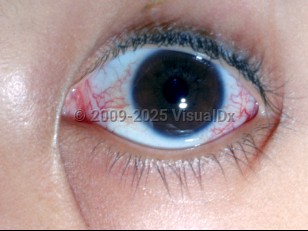Ataxia-telangiectasia syndrome in Adult
Alerts and Notices
Important News & Links
Synopsis

Ataxia-telangiectasia (AT), also known as Louis Bar syndrome, is a rare, autosomal recessive, systemic, complex neurodegenerative disorder with symptoms that begin in late infancy to early childhood. It is characterized by progressive ataxia, choreoathetosis, oculomotor discoordination, skin / eye telangiectasias, and a weakened immune system. The earliest sign of AT is often abnormal head control in infancy, with swaying of the head or abnormal truncal control. Over time, progressive cerebellar dysfunction occurs, resulting in speech and oculomotor apraxia, as well as gait and truncal ataxia. This manifests as slurring of speech and difficulty walking and choreiform movements, progressing to inability to walk, resulting in wheelchair dependance by adolescence. MRI of the brain beyond early childhood will often show a small cerebellum.
AT develops when both copies of the ATM gene contain mutations that affect the production or function of the ATM protein, a serine / threonine kinase responsible for DNA and tumor suppression that is found on chromosome 11 position q 22.3. Because of this impaired DNA repair, patients with AT are very sensitive to the mutagenic effects of ionizing radiation and are at higher risk of developing cancers (38%), predominantly consisting of leukemia (often T cell) and lymphoma (often B cell). Many patients with AT show increased susceptibility to infections (mainly sinopulmonary), with low immunoglobulin levels. Patients with AT will display progressively numerous skin and ocular telangiectasia, usually by age 6 years, beginning first in the whites of the eyes and then involving sun-exposed areas of the face. Other features include premature aging, with graying of the hair, and an increased incidence of endocrinologic disorders, including diabetes mellitus type 2, pubertal delays, and short stature.
AT shows no predilection for sex or race and ethnicity, and it occurs in approximately 1:40 000 to 1:100 000 live births. While most patients with AT have normal intelligence, severe speech and motor apraxia greatly limit functional abilities. Life expectancy is reduced to age 30-40 and is dependent on the severity of immunologic dysfunction, development of cancers, and severity of neurologic impairment and often corelates to the severity of the ATM protein deficiency (with absent ATM being the most severe). Recurrent lung infections can lead to bronchiectasis and interstitial lung disease.
AT develops when both copies of the ATM gene contain mutations that affect the production or function of the ATM protein, a serine / threonine kinase responsible for DNA and tumor suppression that is found on chromosome 11 position q 22.3. Because of this impaired DNA repair, patients with AT are very sensitive to the mutagenic effects of ionizing radiation and are at higher risk of developing cancers (38%), predominantly consisting of leukemia (often T cell) and lymphoma (often B cell). Many patients with AT show increased susceptibility to infections (mainly sinopulmonary), with low immunoglobulin levels. Patients with AT will display progressively numerous skin and ocular telangiectasia, usually by age 6 years, beginning first in the whites of the eyes and then involving sun-exposed areas of the face. Other features include premature aging, with graying of the hair, and an increased incidence of endocrinologic disorders, including diabetes mellitus type 2, pubertal delays, and short stature.
AT shows no predilection for sex or race and ethnicity, and it occurs in approximately 1:40 000 to 1:100 000 live births. While most patients with AT have normal intelligence, severe speech and motor apraxia greatly limit functional abilities. Life expectancy is reduced to age 30-40 and is dependent on the severity of immunologic dysfunction, development of cancers, and severity of neurologic impairment and often corelates to the severity of the ATM protein deficiency (with absent ATM being the most severe). Recurrent lung infections can lead to bronchiectasis and interstitial lung disease.
Codes
ICD10CM:
G11.3 – Cerebellar ataxia with defective DNA repair
SNOMEDCT:
68504005 – Ataxia-telangiectasia syndrome
G11.3 – Cerebellar ataxia with defective DNA repair
SNOMEDCT:
68504005 – Ataxia-telangiectasia syndrome
Look For
Subscription Required
Diagnostic Pearls
Subscription Required
Differential Diagnosis & Pitfalls

To perform a comparison, select diagnoses from the classic differential
Subscription Required
Best Tests
Subscription Required
Management Pearls
Subscription Required
Therapy
Subscription Required
References
Subscription Required
Last Reviewed:10/08/2022
Last Updated:10/30/2022
Last Updated:10/30/2022

